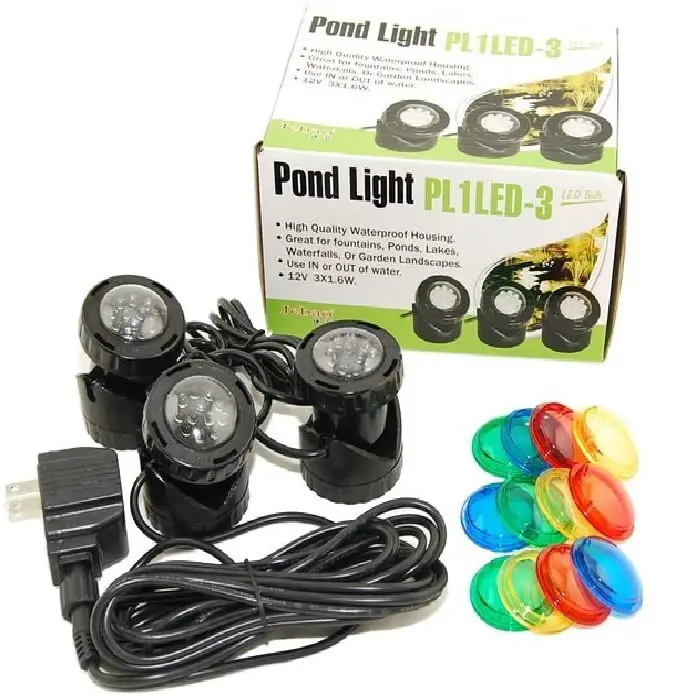
- Brand Jebao
- Material Plastic
- Item Weight 2 Pounds
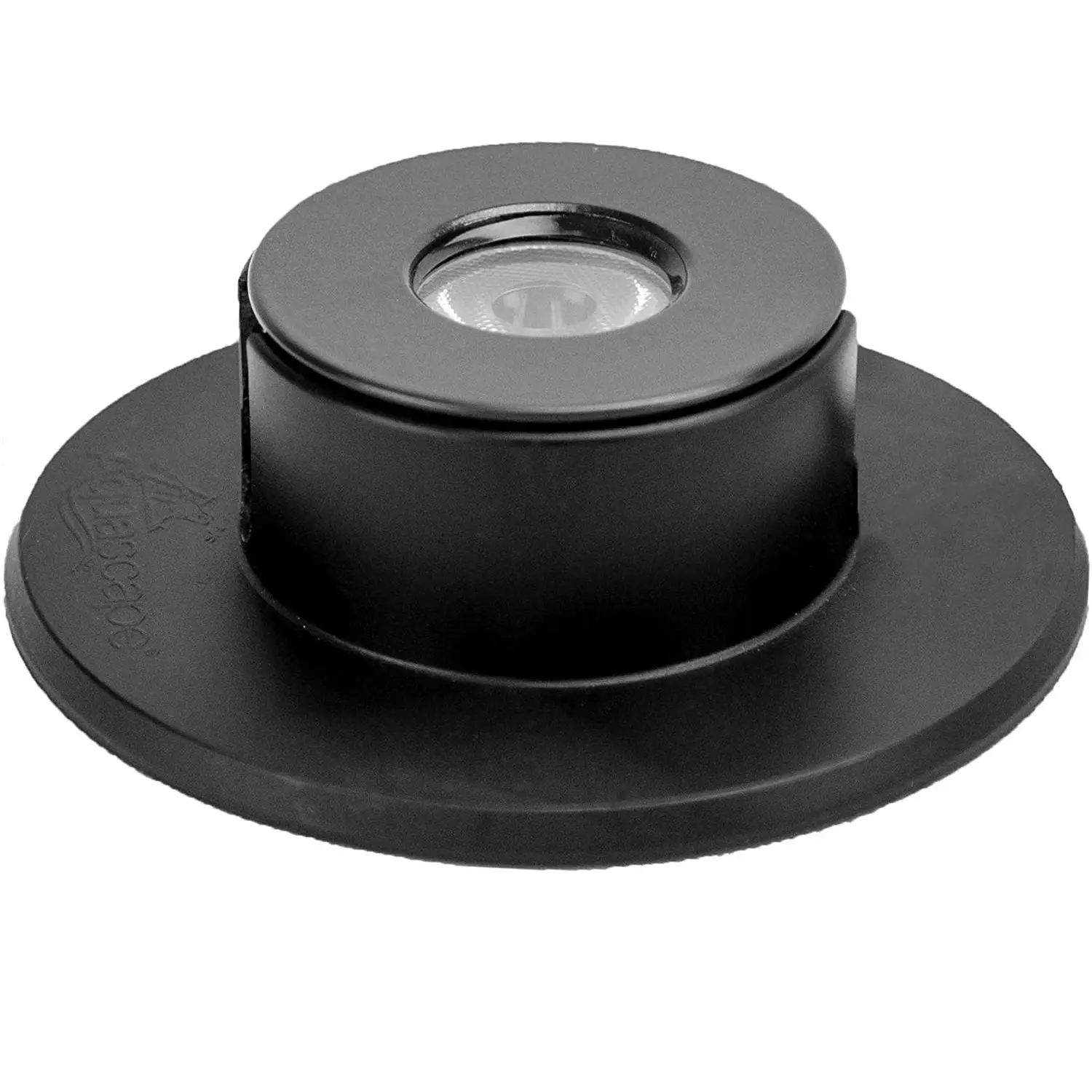
- Color Dark Bronze
- Brand Aquascape
- Material Metal
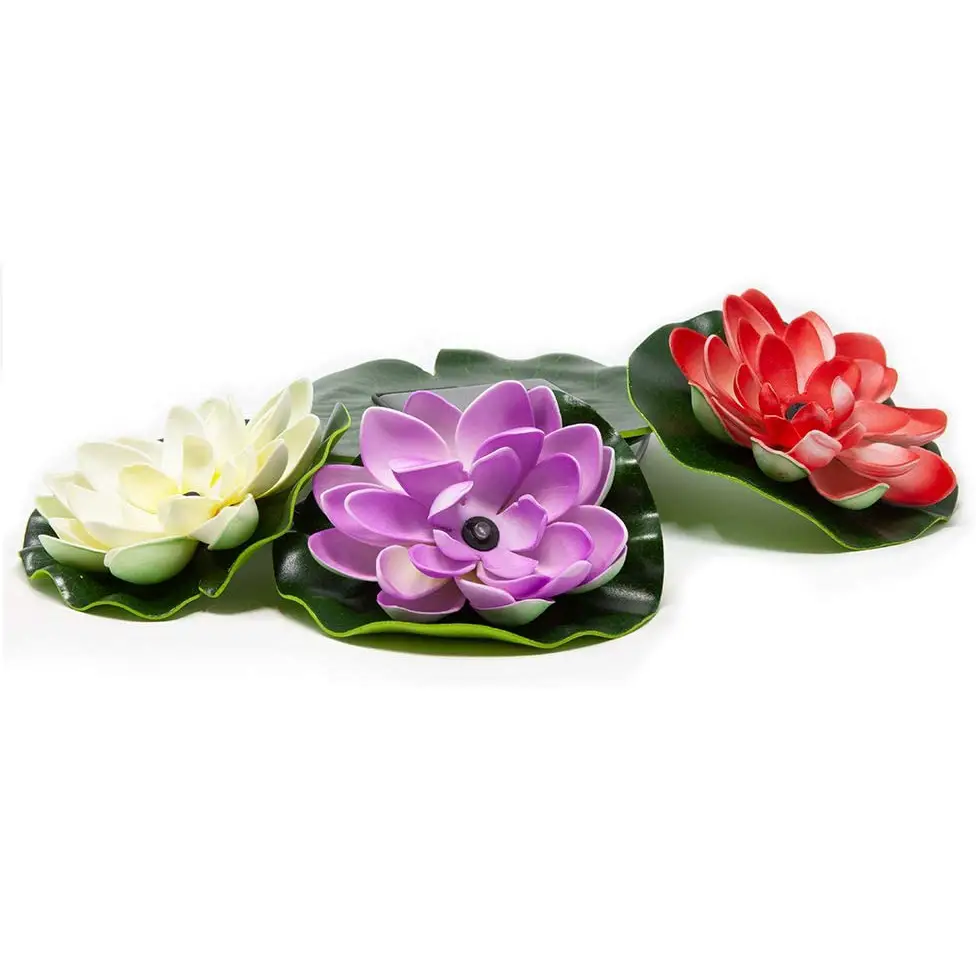
- Color Multicolor
- Beckett Corporation
- Item Weight 0.4 Pounds
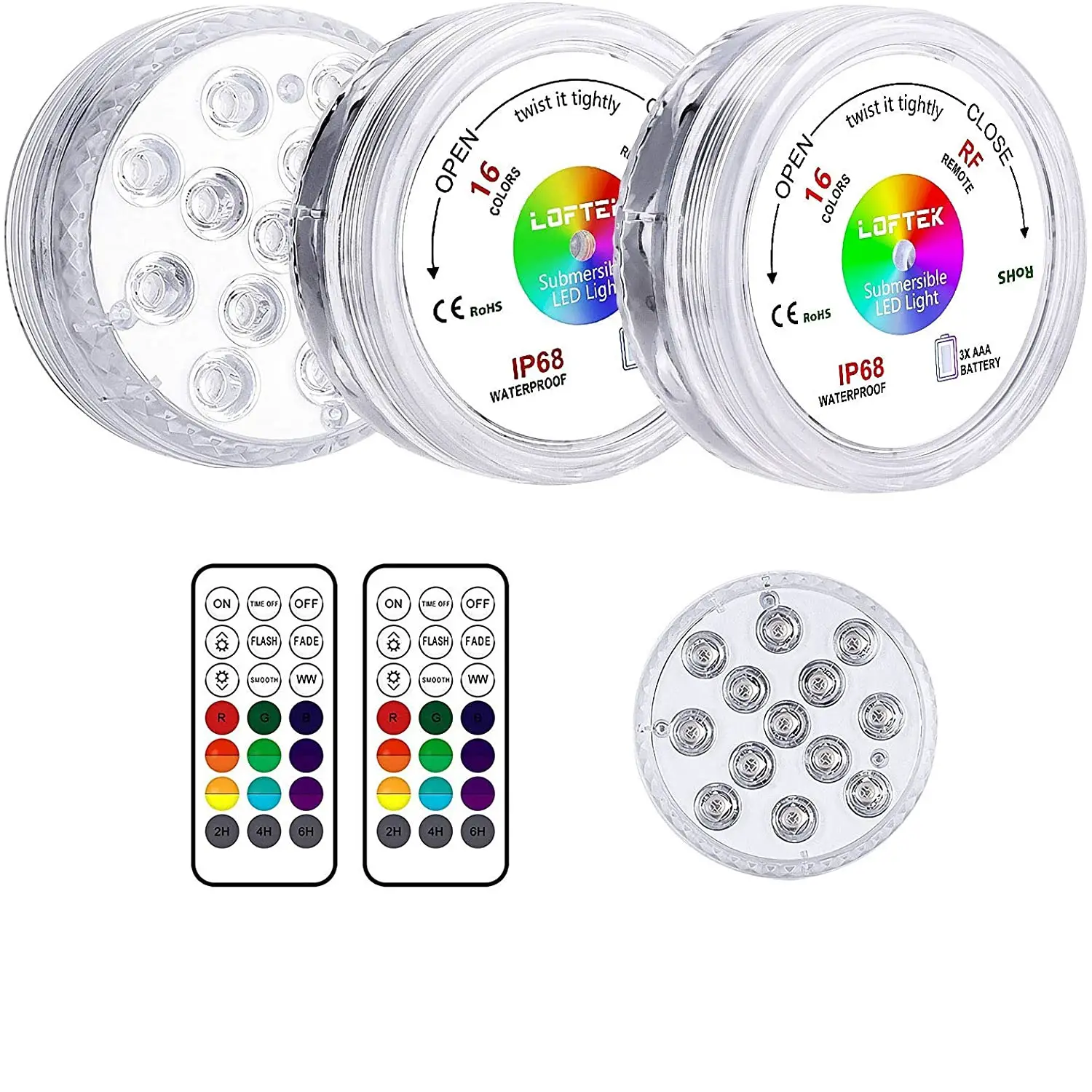
- Brand LOFTEK
- Acrylonitrile Butadiene Styrene
- 9.1 ounces
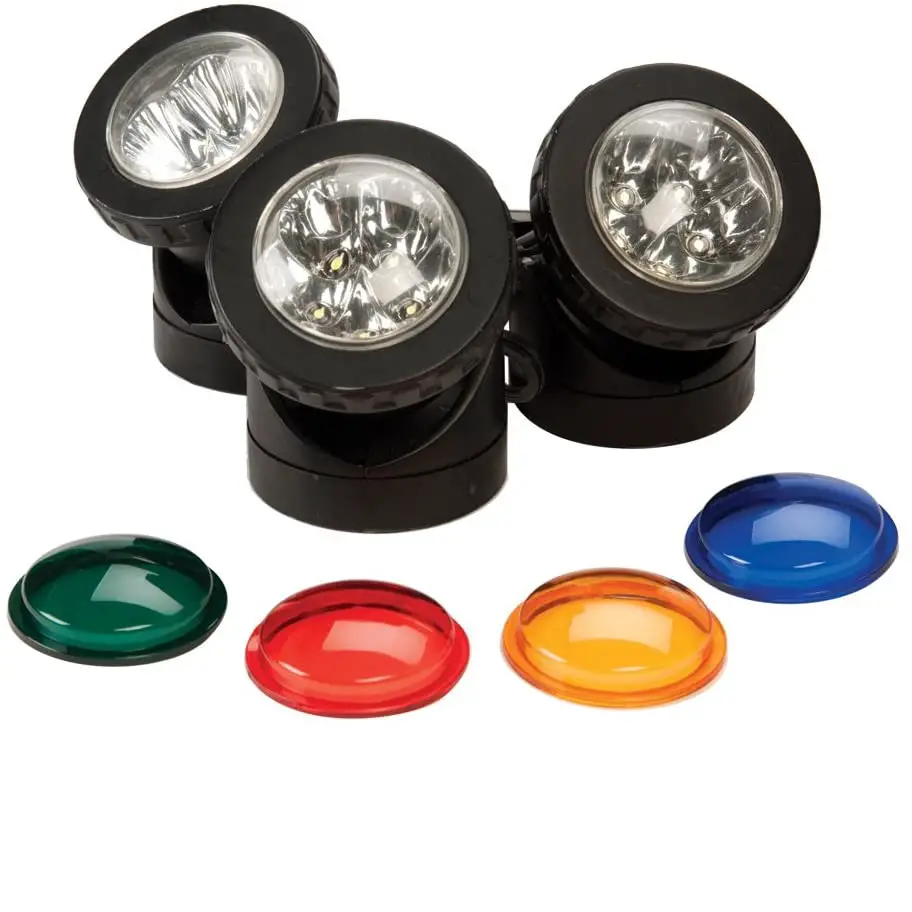
- Brand TotalPond
- Material Plastic
- 2.53 Pounds
Choose the Best Pond Light
Customer’s Choice: the Best Rated Pond Lights
5 users answered this survey. Please help us improve this review!
Looking for a way to make your pond more beautiful and lit? Pond lights are an excellent method to do so. In this article, we will discuss the diverse types of pond lights, and provide some tips on how to choose the best one for your needs. We’ll go through everything about pond lighting, including installation and maintenance. Let’s get started!
Table of Contents
Jebao Submersible LED Pond Light with Photcell Sensor
 It is perfect for those who want to add a little bit of light to their pond without going overboard. The light is automatically switched on at night and off in the morning, thanks to a built-in sensor, so you don’t have to worry about forgetting to turn it on or off.
It is perfect for those who want to add a little bit of light to their pond without going overboard. The light is automatically switched on at night and off in the morning, thanks to a built-in sensor, so you don’t have to worry about forgetting to turn it on or off.
The remote control allows you to change the color of the light and the brightness, so you can customize it to your liking.
Features
- Weight 2 Pounds
- Dimensions LxWxH 10x5x3 inches
- Wattage 4.8 W
- Voltage 12 V
Aquascape 84032 1-Watt Submersible LED Pond and Waterfall Up Light
 This low-wattage light can be used both in and out of water, so it’s great for those who want to highlight features both above and below the surface. It comes with a long power cord (16 feet), so you can easily reach an outlet, and the light itself is small enough.
This low-wattage light can be used both in and out of water, so it’s great for those who want to highlight features both above and below the surface. It comes with a long power cord (16 feet), so you can easily reach an outlet, and the light itself is small enough.
Features
- Weight 1 Pound
- Dimensions LxWxH 1x1x1 inches
- Wattage 1 W
- Voltage 12 V
Beckett Corporation SL3 Solar Lily Pad LED Floating Lights
 These lights are perfect to add some light and color to your pond. The solar-powered LEDs will charge during the day and turn on automatically at night. They come in a set of three, each with six bright LEDs.
These lights are perfect to add some light and color to your pond. The solar-powered LEDs will charge during the day and turn on automatically at night. They come in a set of three, each with six bright LEDs.
The lily pads float on the surface of the water and can be placed anywhere in your pond. They are also waterproof and weather-resistant, so the elements don’t have to worry about them being damaged.
If you’re looking for a fun and unique way to light up your pond, these lily pad lights are a great option.
Features
- Weight 0.4 Pounds
- Dimensions LxWxH 6.5x3x6.5 inches
LOFTEK Submersible LED Lights Waterproof with Remote (RF), Color Changing Underwater LED Light Battery Operated Underwater Lights for Pool (No Silicone Suction Cups)
 They come with a remote, so you can control the colors and settings without ever having to get in the water. Best of all, they’re battery-operated, so you don’t have to worry about running cords across your yard.
They come with a remote, so you can control the colors and settings without ever having to get in the water. Best of all, they’re battery-operated, so you don’t have to worry about running cords across your yard.
Features
- Package Dimensions 6.18×3.78×2.91 inches
- Item Weight 13.1 ounces
TotalPond Pond and Landscape LED Lights, 3-Piece Set
 These are great lights! They are bright and the colors are beautiful. I have them in my pond and they make it look so nice at night. I would definitely recommend these to anyone looking for pond lights. They are solar-powered.
These are great lights! They are bright and the colors are beautiful. I have them in my pond and they make it look so nice at night. I would definitely recommend these to anyone looking for pond lights. They are solar-powered.
Features
- Weight 2.53 Pounds
- Dimensions LxWxH 4.76×5.43×11.14 inches
- Voltage 12 Volts
Buyer’s Guide
Choosing Pond Lights
Pond lights are an excellent way to add a touch of ambiance to your backyard oasis. But with so many diverse types and styles on the market, it can be tough to know where to start.
Let’s get started…
There are two main types: submersible and floating. Submersible lights are designed to be placed directly in the water, while floating lights sit on top of the water’s surface.
Both types of lights can create a beautiful effect, but it’s important to choose the right one. If you have a smaller pond, for example, submersible lights may be the better option as they won’t take up as much space.
On the other hand, if you have a larger pond or lake, floating lights will give you more coverage and allow you to create diverse lighting effects.
Once you’ve decided on the type of light, it’s time to think about power options. Pond lights typically run on either batteries or low-voltage transformers.
IP, or ingress protection, ratings are a measure of how well a light can withstand water and debris. For example, a light with an IP68 rating can be submerged in up to six feet of water for 24 h without any damage.
When it comes to pond lights, you’ll typically see two numbers in the IP rating: the first indicates protection against solid objects like dust, and the second indicates protection against water.
The higher the number, the better protected your light will be. So, if you’re looking for a light that can be submerged in your pond, make sure it has at least an IP68 rating.
Another factor is the light’s color temperature. This is measured in Kelvin and indicates how “warm” or “cool” it appears.
Warm white lights have a lower temperature and give off a yellowish-orange hue, while cool white lights have a higher color temperature and appear more blue.
Which you choose is entirely up to personal preference, but it’s worth considering how the different colors will affect the overall look of your pond.
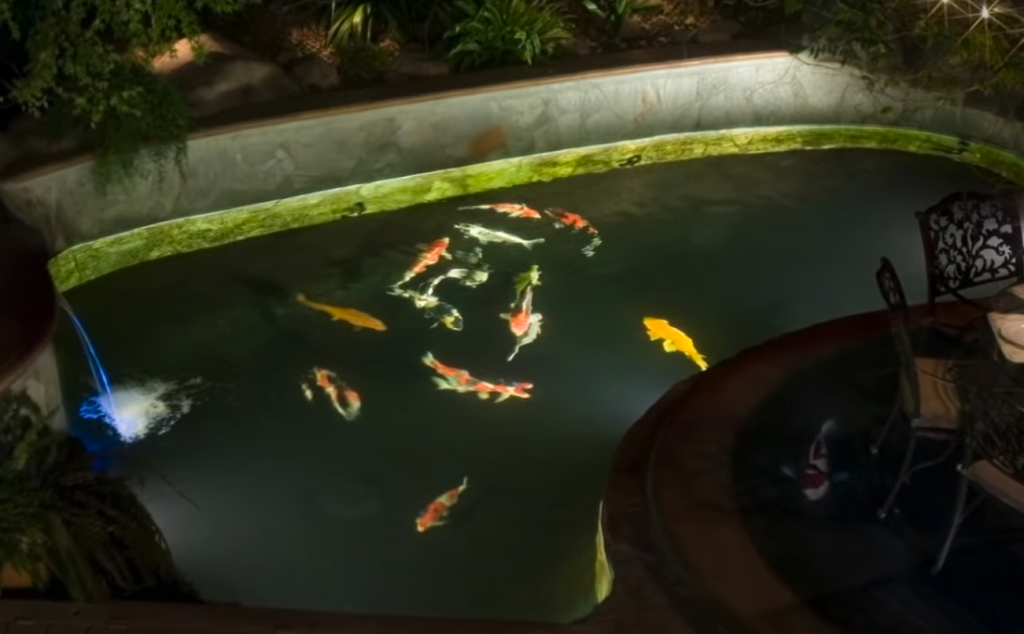
Finally, you’ll need to decide on the beam angle of your pond lights. The beam angle is simply the width of the light beam, and is typically expressed in degrees.
Narrow beams have a smaller angle (usually between 15 and 30 degrees) and give off a more focused light, while wide beams have a larger angle (usually between 60 and 120 degrees) and provide more diffused light.
Again, it’s a matter of personal preference, but if you’re not sure which to choose, narrow beam lights are a good option for smaller ponds, while wide beam lights work well for larger ponds.
Quantity
Now that you know what to look for in pond lights, it’s time to think about how many you need. A good rule of thumb is to use one light for every square foot of surface area.
Of course, this is just a general guideline – you may want to use more or less depending on the effect you’re trying to create.Color
As we mentioned earlier, pond lights are available in both warm white and cool white. Warm white lights have a yellowish-orange hue and create a cozy, inviting atmosphere.
Cool white lights appear more blue and give off a bright, crisp light. Again, it’s a matter of personal preference, but we generally recommend using warm white lights for smaller ponds and cool white lights for larger ponds.
If you want to get really creative, you can also find pond lights that change color. These “RGB” (red-green-blue) lights allow you to create any number of different lighting effects by changing the color of the light.
For example, you could use red and green RGB lights to create a festive look for Christmas, or blue and white lights to give your pond a wintery feel.
Power
Pond lights typically run on either batteries or low-voltage transformers. Batteries are convenient because they don’t require any wiring, but they need to be replaced regularly and generally don’t last as long as transformer-powered lights.
Transformer-powered lights are more permanent, but they do require some basic wiring. If you’re not comfortable doing this yourself, you may want to hire an electrician to do it for you.
Durability and Warranty
As we mentioned earlier, it’s important to choose a pond light with a high IP rating. This will ensure that your light can withstand being submerged in water for extended periods of time.
In addition, look for lights that are made from durable materials like stainless steel or aluminum. These materials won’t rust or corrode when exposed to water and will last much longer than cheaper plastic lights. [1]
Finally, make sure the pond light you choose comes with a warranty. This will protect you in case of any manufacturing defects and give you peace of mind knowing that your investment is protected.
How Will Your Pond Lights Be Powered?
There are three primary ways to power your pond lights: batteries, solar, or low-voltage transformers. Each has its own benefits and drawbacks that you’ll want to consider before making a purchase.
Batteries are the simplest option – they can be placed just about anywhere and don’t require any wiring. However, they will need to be replaced periodically, and depending on how often the lights are used, this can become expensive.
Solar pond lights are becoming increasingly popular as they’re eco-friendly and easy to install. However, they rely on sunlight to work properly, so if you live in an area with long winters or little sun, they may not be the best option for you.
Low-voltage transformers are the most expensive option, but they’re also the most reliable. They require wiring to be installed, but once it’s in place, you won’t have to worry about replacing batteries or making sure there’s enough sun.
How Easy Is The Pond Light To Install?
This is one of the most important factors to consider when choosing your pond light. If you’re not experienced with electrical work, then you’ll want to choose a light that is easy to install. Many lights come with detailed instructions, so make sure to read them before making your purchase.
Similarly, if you’re hiring someone to install your pond lights, be sure to ask about their experience and whether they think the light will be easy to install.
Finally, take a look at online reviews of the pond light you’re considering. Customers will often mention how easy or difficult the installation process was. This can give you a good idea of what you can expect.
Pond Light Placement And Mounting
Differentiating between pond lights and garden lights is important. Garden lights are usually placed around the perimeter of a pond, while pond lights are placed inside the water. This distinction is important because each type of light has different IP (ingress protection) ratings. Garden lights typically have an IP44 rating, which means they’re protected against splashing water from any direction. Pond lights must have an IP68 rating, which means they’re completely sealed and can be submerged in water up to a depth of one meter without sustaining any damage.
Pond lights can be either floating or submersible, but submersible pond lights are more popular because they’re less likely to be damaged by debris or animals. Submersible pond lights are also easier to install because they don’t require any special mounting hardware.
Most pond lights come with a cord that plugs into an outdoor outlet, but there are also solar-powered pond lights available. Solar-powered pond lights are a good choice if you want to avoid running cords across your yard, but they may not provide as much light as wired pond lights.
If you decide to go with wired pond lights, be sure to use an outdoor-rated extension cord and waterproof wire connectors. It’s also important to keep the cord away from areas where it can be chewed on by animals or damaged by lawnmowers or other yard equipment.
When installing pond lights, always consult the manufacturer’s instructions because there may be specific requirements for your particular model. In general, however, pond lights should be placed around the edge of the pond so they illuminate the water without casting shadows. For best results, place the lights at least two feet away from the edge of the pond.
Safety First!
Before you start shopping for pond lights, it’s important to keep safety in mind. Pond lights can get very hot, so be sure to choose a light that is rated for use around water. Also, be sure to read the instructions carefully before installation and never leave the lights on unattended.
Finalizing Your Pond Light Installation
When you’re ready to finalize your pond light installation, there are a few things to keep in mind. First, make sure that the power source for your lights is properly grounded.
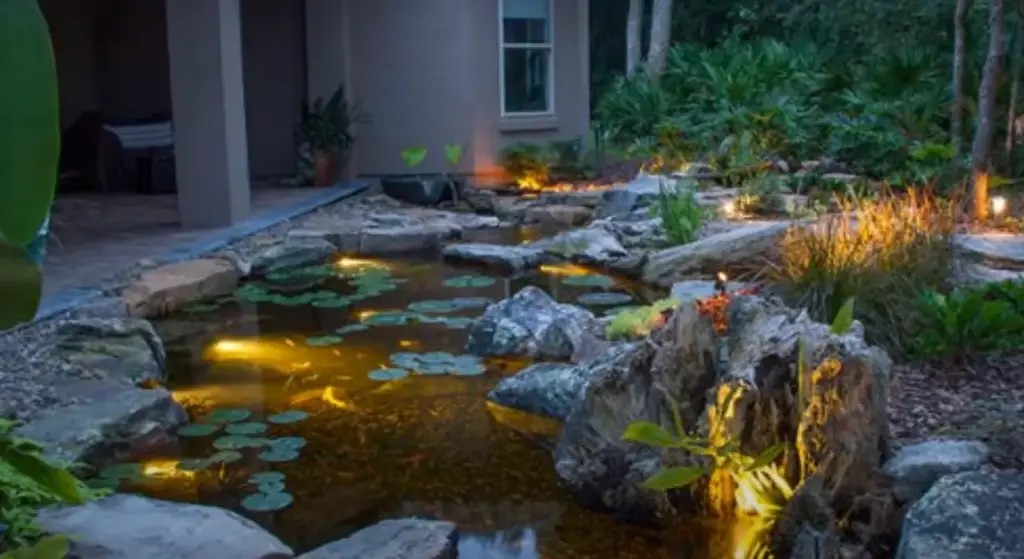
This will help to prevent any electrical shocks or fires. Secondly, be sure to waterproof all of the connections between your lights and the power source. Finally, test your lights before you leave them on for extended periods of time.
Burying Cables
Once you have your pond lights installed, you may want to consider burying the cables and hiding the lights. This can be done by using an underground PVC conduit or by running the cables through an existing garden hose. If you bury the cables, be sure to use a waterproof sealant on all of the connections. By taking these precautions, you can ensure that your pond lights will last for many years to come.
Types Of Pond Lighting System
There are several types of pond illumination systems on the market, but we’ve compiled a list of the most popular ones below.
Solar Pond Lights: Solar pond lights are one of the most popular types on the market. They are easy to install and don’t require any wiring. Simply place them in your pond and let the sun do its job!
LED Pond Lights: LED pond lights are another popular option. They are energy-efficient and have a long lifespan. Plus, they come in a variety of colors to choose from.
Submersible Pond Lights: Submersible pond lights are great for adding ambiance to your pond.
Floating Pond Lights: Another fantastic approach to increase lighting in your pond is with floating pond lights. They can be placed in the middle of your pond or around the perimeter.
Downlighting
Downlighting is a popular type of pond lighting. It involves placing lights around the perimeter of your pond and pointing them downwards. This creates a “moonlight” effect that is both beautiful and calming.
Upward-facing lights can also be used to create a similar effect. However, downward-facing lights are more commonly used because they are less likely to disturb wildlife.
Uplighting
If you want to add some drama to your pond, consider using uplighting. This involves placing lights under the water and pointing them upwards. This creates an eerie but stunning effect that will definitely turn heads!
Submersible Lighting
Submersible lighting is a great way to add light to your pond without disturbing the natural ecosystem. These lights can be placed in various areas around your pond, such as in the center or near plants.
LED Lights vs. Halogen Lights – Which Is Better?
If you’re looking to light up the pond, you have two main types of light bulbs to choose from – LED lights and halogen lights. So which is better?
LED lights are more energy-efficient than halogen lights, meaning they’ll cost you less in the long run. They also last longer, so you won’t have to replace them as often. On the downside, they can be more expensive upfront.
Halogen lights are cheaper upfront but they use more energy and need to be replaced more frequently. They do produce a brighter light, however, so if that’s what you’re after then they may be the better option for you.
At the end of the day, it’s up to you to decide which type of light is best for your pond. Consider your budget and your needs before making a decision.
How To Install Pond Lights
Installing pond lights is a simple process that anyone can do. You’ll need a few basic tools and materials, and then you can follow these steps:
First, choose the location for your pond lights. You’ll want to consider things like where the sun hits during different times of day, what kind of view you want from your patio or deck, and whether you have any plants or other features that you want to highlight.
Step 1: Secure The Area
The first thing you need to do is make sure the area around your pond is secure. You don’t want anyone accidentally falling in, so remove any trip hazards and make sure there’s a good fence or barrier in place. If you have young children, you might also want to consider installing a pond cover to keep them safe.
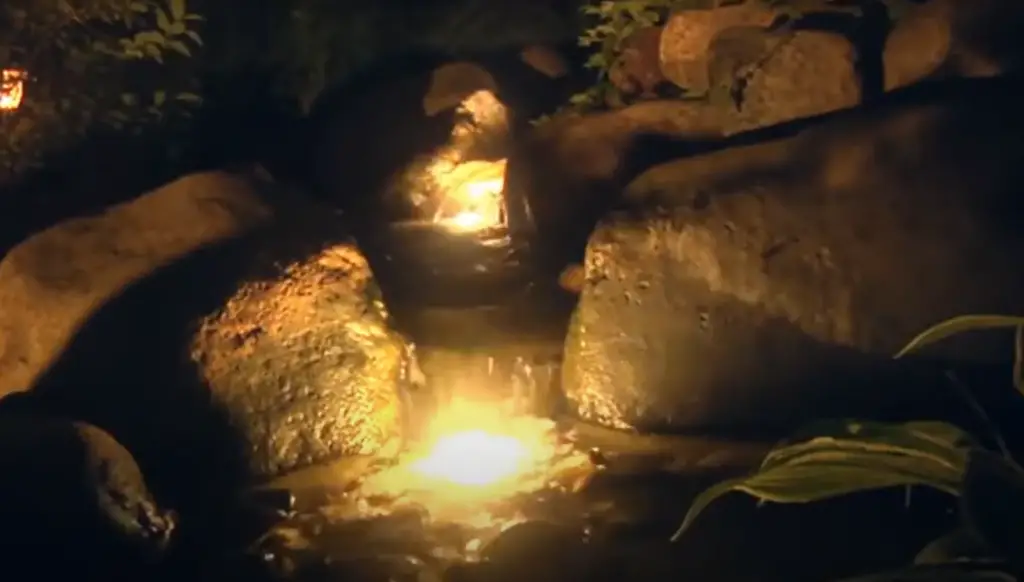
Now that the area is secure, it’s time to start thinking about what kind of lights you want to install. There are lots of different options on the market, so it’s important to do some research before making a purchase. Here are a few things you should keep in mind:
- The size of your pond: You’ll need to buy lights that are specifically designed for ponds, and the size of your pond will dictate how many lights you need
- The look you’re going for: Do you want subtle lighting that creates a gentle ambiance, or do you want something more dramatic? There are lots of different options to choose from, so think about the overall look you’re trying to achieve.
- Your budget: Lights can range in price from a few dollars to hundreds of dollars, so it’s important to set a budget before you start shopping.
Step 2: Installation Procedure
Now that you have everything you need, it’s time to get started on installation! The process is actually pretty simple, and can be broken down into a few easy steps:
First, find a suitable location for your light. This is typically near the edge of the pond so that the light will shine across the water surface. If possible, try to position the light so that it is not in direct sunlight, as this can cause algae growth.
Next, dig a small hole at the chosen location. The hole should be big enough to accommodate the light fixture and cord. Once the hole is dug, carefully place the light fixture into it.
If necessary, use some rocks or soil to secure the fixture in place.
Now, connect the power cord to the fixture, and plug it into an outlet. Be sure to use a waterproof outlet cover if one is not already in place. Once everything is plugged in, turn on the light switch and enjoy your new pond lights!
Common Pond Lighting Mistakes
Pond lighting is one of the most important aspects of creating a beautiful and inviting outdoor space. But it can also be one of the most challenging to get right. There are a few common mistakes that people make when choosing and installing pond lights, which can ruin the look of your pond and even damage your fish.
Here are four common mistakes to avoid when choosing and installing pond lights.
Lack Of Planning
One of the most common mistakes people make when installing pond lights is not taking the time to plan ahead. It’s important to think about things like where you want the light to be placed, how bright you want it to be, and what type of lightbulb you want to use. Taking the time to plan ahead will save you a lot of hassle in the long run.
Not only should you plan ahead for where you want your pond lights to be installed, but also how many you need. Too often people underestimate how much light their pond will need and end up with an inadequate lighting system.
It’s important to find a balance that works for you and your pond.Lights placed too close to the water’s surface can create a “glare” effect that is unpleasant for both you and your fish. It can also make it difficult to see into the pond, defeating the purpose of having lights in the first place. To avoid this, be sure to place your lights at least a few feet away from the edge of the pond.
Incorrectly installed or poorly made pond lights can pose a serious threat to your fish and other aquatic creatures. Be sure to follow all manufacturer instructions carefully and have any electrical work done by a qualified professional. Improperly installed pond lights are not only a danger to your fish, but they can also be a fire hazard.
Improper Placement
One of the most common mistakes people make when installing pond lights is improper placement. Not only does this make it difficult to see your pond at night, but it can also be a safety hazard. Be sure to place your lights so that they are visible from all angles, and keep them away from any areas where children or pets play.
Another common mistake is not waterproofing your lights properly. This can lead to short circuits and fires, so be sure to follow the instructions carefully when installing your lights.
Buying Cheap Fixture
You might be tempted to buy the cheapest fixture you can find but this is not always the best idea. The cheaper fixtures are often made with lower quality materials and they may not last as long. It is better to invest in a higher quality fixture that will last longer and provide you with better lighting.
Another thing to consider when purchasing pond lights is the warranty. Most high-quality manufacturers offer a warranty on their products. This means that if something goes wrong with the light, you can return it or get it repaired without having to pay for a new one. Warranties are especially important if you plan on using your pond lights for an extended period of time.
Placing Transformer Far
You will want to place your transformer as far away from the pond as possible. This is for two reasons: one, to keep it away from any water that might splash up; and two, to avoid having any cords running across your pond (which can be unsightly). If you have a large pond, you may need to use an extension cord to reach the transformer. Be sure to use an outdoor-rated extension cord that is rated for the wattage of your transformer. Also, make sure that the extension cord is plugged into a GFCI outlet!
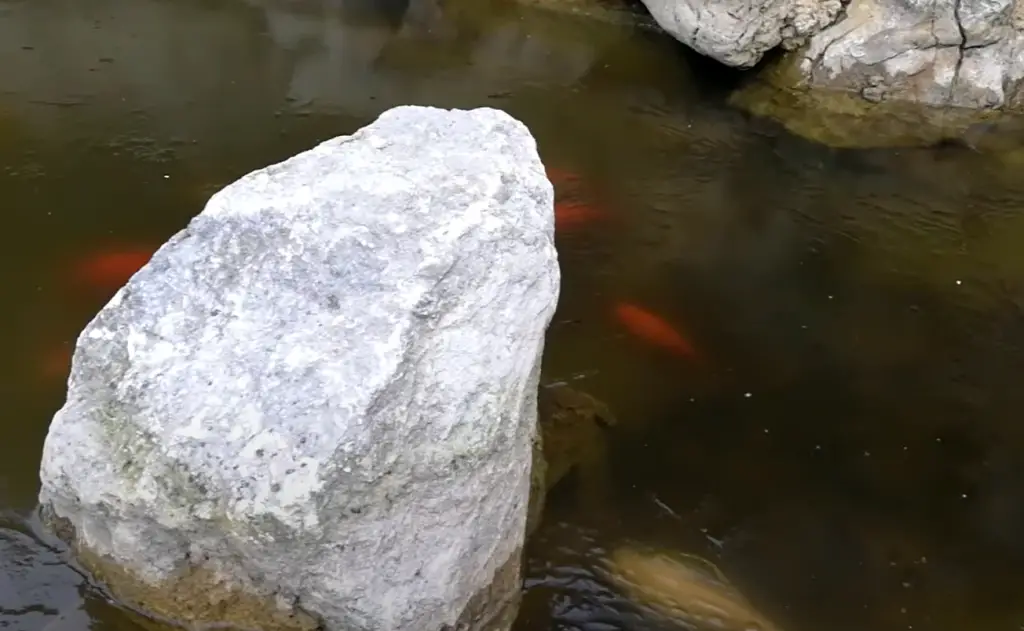
Another thing to consider when placing your transformer is whether or not it will be in direct sunlight. If it will be, you’ll want to choose a spot that gets some shade during part of the day. This will help extend the life of your transformer.
Finally, you’ll want to make sure that your transformer is easily accessible for maintenance and repairs. This means placing it in a spot where you can easily get to it, without having to move furniture or other obstacles out of the way. A good rule of thumb is to place it somewhere where you can reach it with a garden hose – that way, if water does splash up on it, you can easily rinse it off.
Lack Of Maintenance
If you don’t maintain your pond lights, they will quickly become useless. This is because the build-up of dirt and debris can cause the light to become dimmer over time. In addition, if you don’t clean the lens regularly, the light will eventually stop shining altogether.
To avoid this, it’s important to clean your pond lights on a regular basis. You can do this by using a soft cloth and some mild soap. Be sure to rinse the lights thoroughly afterwards to remove any soap residue.
It’s also a good idea to check the wiring periodically to make sure it’s in good condition. If you notice any fraying or exposed wires, be sure to replace them immediately.
Excessive Lightings
If you have ever been to a casino, you know that they are deliberately kept very bright. The reason for this is twofold. First, it helps keep gamblers awake and alert. Second, it makes it difficult for people to hide their facial expressions, which can give away tells.
The same principles apply to ponds. Too much light can make fish more active, which can be disruptive to their natural patterns and behavior. It can also cause algae to grow more quickly, leading to pond maintenance problems down the road.
For these reasons, it is important to find a balance when selecting pond lights. You want enough light to see the fish and enjoy the beauty of your pond at night, but not so much that it becomes a nuisance.
A good rule of thumb is to use one light for every two square feet of pond surface area. So, if you have a pond that is 20 feet long and 15 feet wide, you would need ten lights.
You can also use solar-powered lights to help reduce your energy consumption. These lights are placed in the sun during the day and then turn on automatically at dusk, providing up to eight hours of light per night.
Finally, be sure to position your lights so that they point down into the pond rather than out towards the shoreline. This will help prevent shadows from being cast onto the water, making it easier for you to see your fish.
Not Properly Burying Cable
One of the most common mistakes people make when installing outdoor lighting is not properly burying their cable. This can create two problems: first, if the wire is left exposed it can be a trip hazard; second, if the wire is not buried deep enough, freezing temperatures can cause it to break. When running cable for your outdoor lights, make sure to bury it at least six inches deep. If you live in an area with particularly cold winters, you may want to bury it even deeper.
Another mistake people often make when installing outdoor lights is using the wrong type of light bulb. Outdoor lights are exposed to the elements and need to be able to withstand rain, snow, and ice. Make sure to use bulbs that are rated for outdoor use; otherwise, you run the risk of them burning out prematurely. [2]
Finally, one of the most important things to keep in mind when installing outdoor lights is safety. If you are running electrical wire, make sure to do so safely and in accordance with local codes. If you are not comfortable doing this yourself, hire a professional electrician to do it for you.
Things To Consider When Buying Submersible Pond Lights
When it comes to choosing submersible pond lights, there are a few things you need to take into account.
Will They Be Bright Enough?
You don’t want your pond lights to be too bright. Not only will it be a waste of energy, but it can also disturb the natural ecosystem of your pond. You should look for pond lights that are labeled “low voltage” or “energy-efficient.” These will use less power and produce less light pollution.
Another thing to consider is the color of the light. Some people prefer white LED lights because they provide a natural look. Others prefer colored lights because they add a festive touch to their ponds. There are even some Pond Lights that change colors!
A good rule of thumb is to choose a light with a color temperature of 3000K-4000K.Does It Support Multiple Colors?
If you want a more versatile light, look for one that has multiple colors. This way, you can change the look of your pond whenever you want. You can even use different colors to create a certain mood.
Most pond lights will have at least two colors: white and blue. However, some lights will have up to 16 different colors. If you’re not sure which light to get, opt for one with more color options. That way, you can always find the perfect shade for your pond.
How Easy Is The Pond Lights To Install?
One of the best things about pond lights is that they are relatively easy to install. You won’t need to hire a professional or do any complex wiring – in most cases, you can simply plug them in and enjoy the show.
However, it’s always a good idea to read the instructions carefully before you get started, just to be sure. And if you’re not confident in your DIY skills, it’s always worth asking a friend or family member for help.
Pond Light Placement And Mounting
When it comes to pond lights, placement and mounting options are important considerations. Placement will determine how well your pond is lit and how the light affects the overall look of your pond. Mounting options will determine how easy or difficult it is to install and maintain your pond lights.
There are a few things to keep in mind when choosing the best location for your pond lights:
- The size of your pond: Smaller ponds will require fewer lights than larger ponds.
- The depth of your pond: Deeper ponds will require more powerful lights that can reach the bottom.
- Your climate: If you live in an area with extreme weather conditions, you’ll need to choose durable lights that can withstand the elements.
- Your budget: More expensive lights will usually offer more features and better quality than less expensive lights.
How Will Your Pond Lights Be Powered?
One of the first things you’ll need to consider when shopping for pond lights is how you’ll power them. Solar-powered pond lights are becoming increasingly popular, as they’re environmentally friendly and easy to install. If you choose solar pond lights, be sure to get ones with high-quality solar panels that will produce enough energy to keep the lights running for several hours each night.
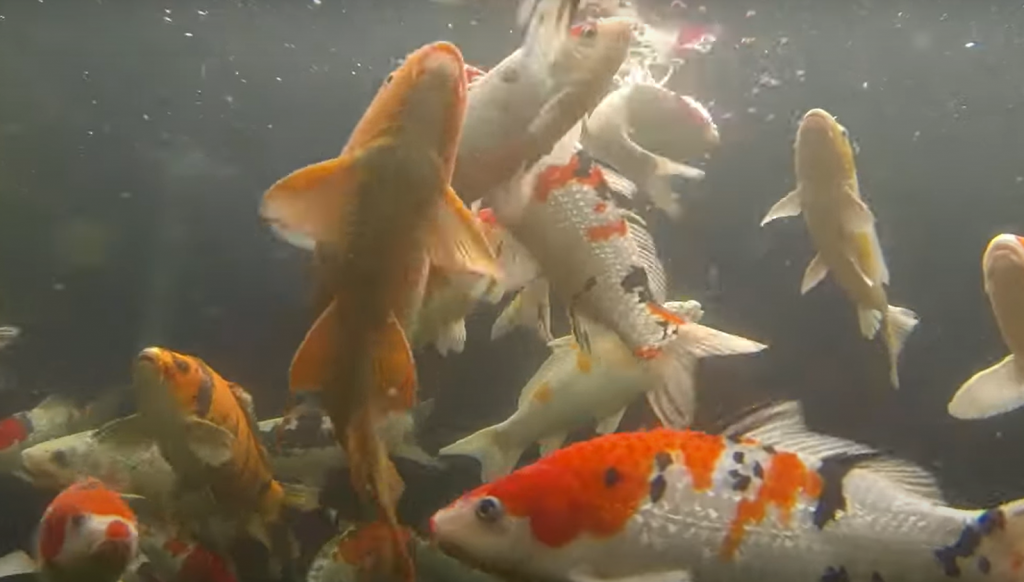
If you don’t want to rely on solar power, you can also choose from a variety of battery-operated or plug-in pond lights. Battery-operated pond lights are typically more expensive than solar-powered ones, but they offer the advantage of not having to be placed in direct sunlight in order to work properly. Plug-in pond lights are the most traditional option, but they do require that you have an electrical outlet near your pond.
Safety
Since pond lights will be placed near water, it’s important to make sure that they’re safe to use. Look for pond lights that are made with waterproof and weatherproof materials, such as plastic or stainless steel. You’ll also want to make sure that the cords are designed to be used outdoors and that they’re not likely to become frayed or damaged over time. [3]
Finally, be sure to read the instructions carefully before installing or using your pond lights. This will help you avoid any potential hazards and ensure that you get the most out of your new pond lighting system.
FAQ
How do you illuminate a pond?
There are a few different ways that you can illuminate a pond. You can use solar lights, LED lights, or even regular light bulbs. The best way to determine which option is best for you is to consider your budget and the look that you are going for.
If you are on a tight budget, then solar lights are probably your best bet. They are very inexpensive and easy to install. You can find them at most home improvement stores.
LED lights are more expensive than solar lights, but they last much longer and use less energy. They also produce a brighter light, so if you want your pond to really stand out at night, then LED lights are the way to go.
Regular light bulbs can be used to illuminate a pond, but they are not as energy efficient as LED lights and they don’t last as long. However, they are the cheapest option, so if you are just looking for a temporary solution, then regular light bulbs will do the trick. [4]
Whatever option you choose, make sure that you buy high-quality lights so that they will last longer and not cause any damage to your pond. Also, be sure to follow the manufacturer’s instructions carefully so that you don’t end up harming your pond or yourself.
Can I put lights in my pond?
Yes! You can put lights in your pond and it can look really great. There are different types of lights you can buy, and each has its own purpose. You can find pond lights at your local hardware store or online.
Pond lights come in different shapes, sizes, and colors. Submersible lights are the most popular form of lighting. These are small lights that you place under the water. They can vary in color, and they do so over time.
Another popular type of pond light is the floating light. These are larger than submersible lights and they float on the surface of the water. They also come in different colors and some even change color over time. [5]
You can also buy solar-powered pond lights. These are the most environmentally friendly option because they don’t use any electricity.
If you want to add some light to your pond but don’t want to spend a lot of money, you can buy LED lights. LED lights are very energy efficient and last a long time.
Can you put lights in a koi pond?
Yes, you can put lights in a koi pond! In fact, it can create a beautiful and calming nighttime atmosphere. However, there are a few things to consider while selecting and putting pond lights in place. First, be sure to choose lights that are specifically designed for use in ponds and other wet areas. Second, it is important to install the lights properly so that they do not pose a drowning hazard for your koi or other aquatic creatures.
What lights work underwater?
Most people don’t realize that there are actually quite a few different types of lights that work well underwater. You have probably seen some of these lights before, but didn’t know that they could be used in ponds and other water features. Here is a list of some of the most popular underwater lights:
- Submersible LED Lights: They are very versatile and come in a wide variety of colors. They can be used to create any type of lighting effect that you want, and they are also very energy efficient.[6]
- Floating Pool Lights: These lights are great for creating a romantic ambiance in your pond or pool. They float on the surface of the water and provide a gentle, diffused light that is perfect for relaxing in.
- Underwater Flood Lights: These lights are ideal for accentuating features in your pond or pool, such as rocks or waterfalls. They can also be used to create a dramatic lighting effect for parties and other special occasions.
How Will Your Pond Lights Be Powered?
You’ll need to think about how you’ll power your pond lights. Will you use an extension cord? If so, make sure it is long enough and that it can handle the wattage of your lights. You may also want to invest in a waterproof outdoor outlet. Another option is to use solar-powered lights. These are becoming increasingly popular as they are environmentally friendly and easy to install.
If you choose solar lights, be sure to do your research to find high-quality lights that will provide enough light for your needs. Also, keep in mind that solar lights require sun exposure to work well, so be sure to place them accordingly.
Finally, battery-operated pond lights are another possibility. These can be convenient as you don’t have to worry about running cords or finding a place to plug them in. However, batteries can be expensive and you’ll need to remember to change them regularly.
Are Pond Lights Fish Safe?
This is a common question that we get asked a lot. The answer is YES, pond lights are definitely fish safe! In fact, many people use them to create beautiful underwater lighting effects in their ponds and aquariums. [7]
Pond lights are also safe for plants and other aquatic creatures.
Useful Video: 8 Best Pond Lights 2019
Conclusion
Pond lights are a fantastic method to spruce up your pond and make it more visible at night. However, before you purchase any pond lights, be sure to do your research so that you can find the best possible option for your needs. With a little bit of time and effort, you can easily find the perfect pond lights for your home. Thanks for reading! We hope this guide was helpful!
References:
- https://www.utahlights.com/blog/choosing-the-right-submersible-pond-light-for-your-landscape-lighting-system
- https://expertaquarist.com/best-pond-lights/
- https://shirleyaquatics.co.uk/knowledge/pond-lighting-what-you-need-to-know/
- https://www.utahlights.com/blog/downlights-vs.-submersible-pond-lights-which-option-will-make-your-pond-sparkle
- https://sacramentokoi.com/20-questions-to-ask-yourself-before-building-a-koi-pond/should-i-install-underwater-lights-in-my-pond/
- https://underwaterfishlight.com/underwater-fishlights/different-types-underwater-lights/
- https://expertaquarist.com/do-pond-lights-bother-fish/

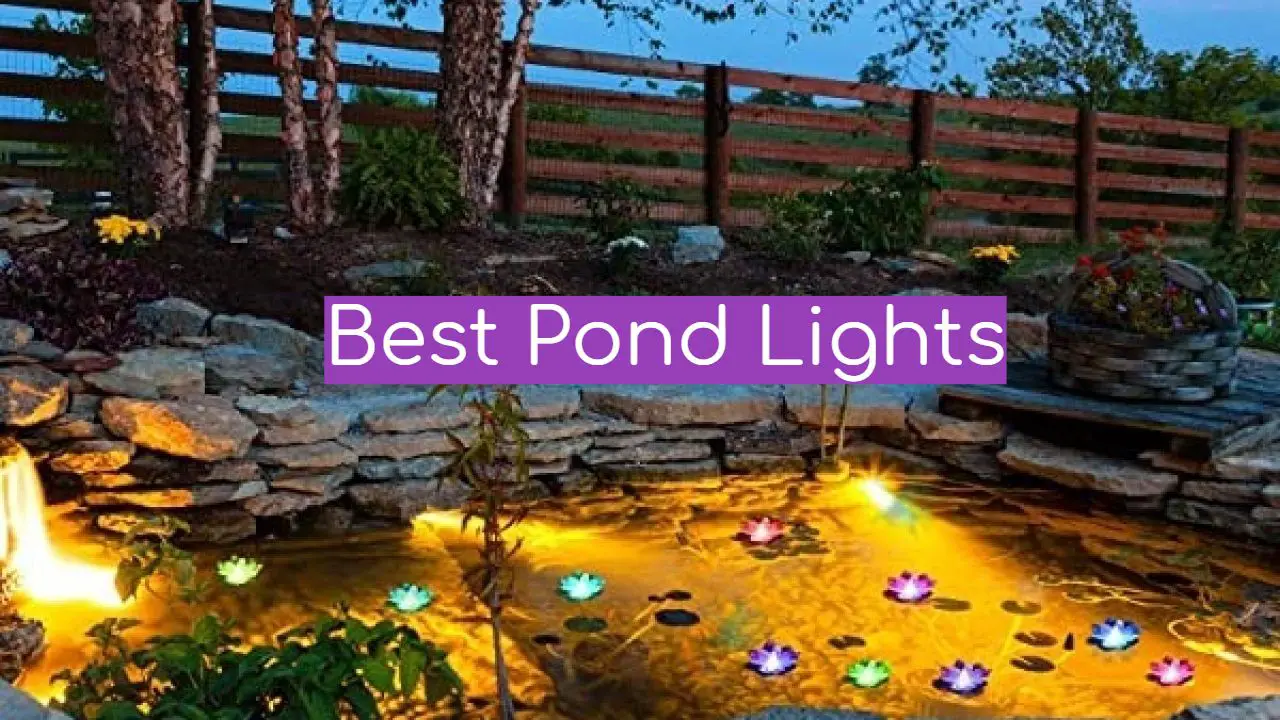
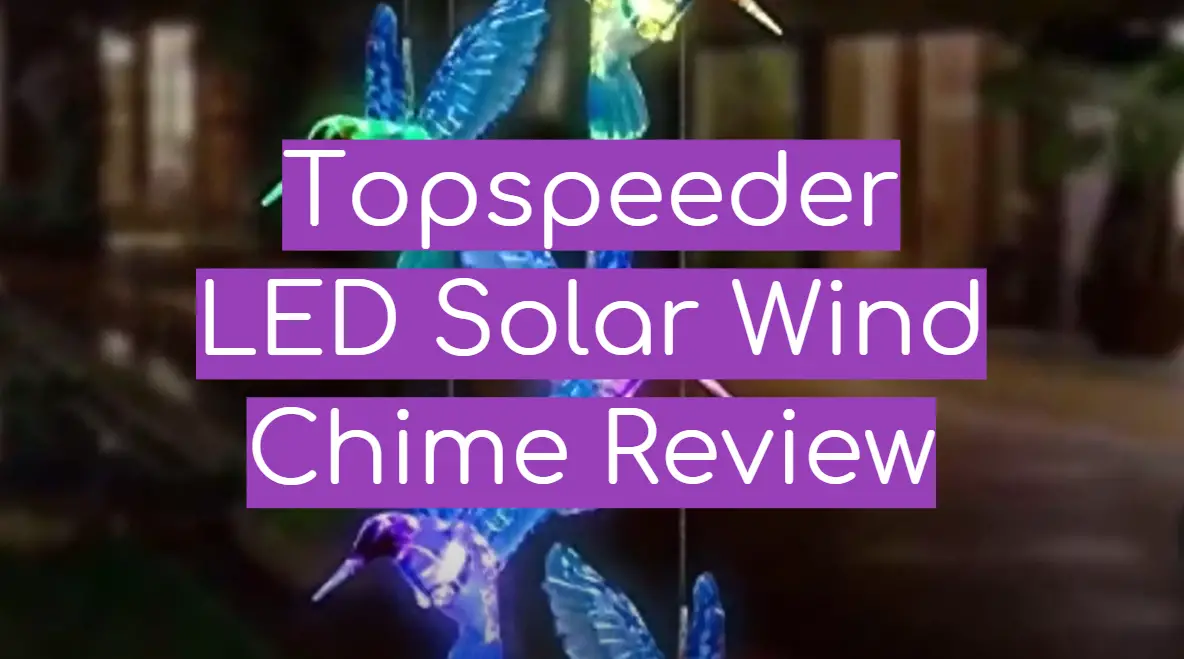
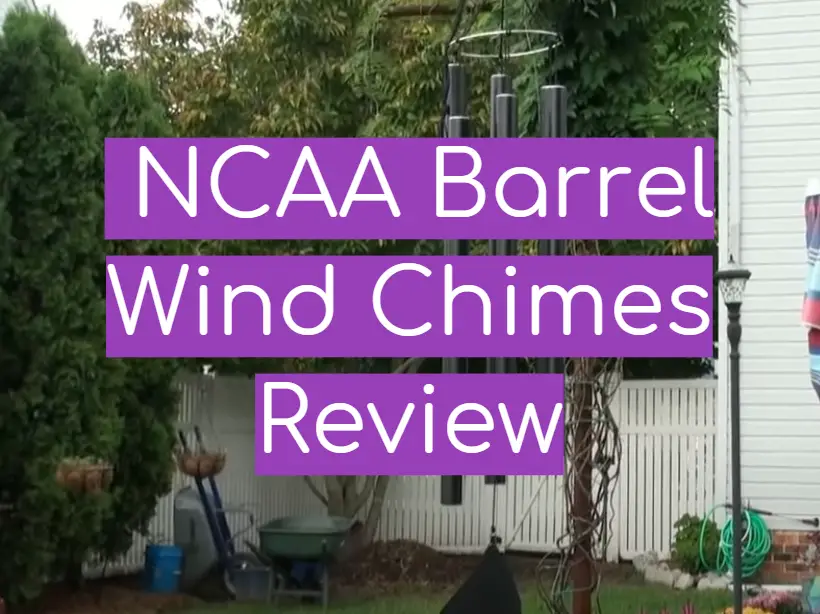

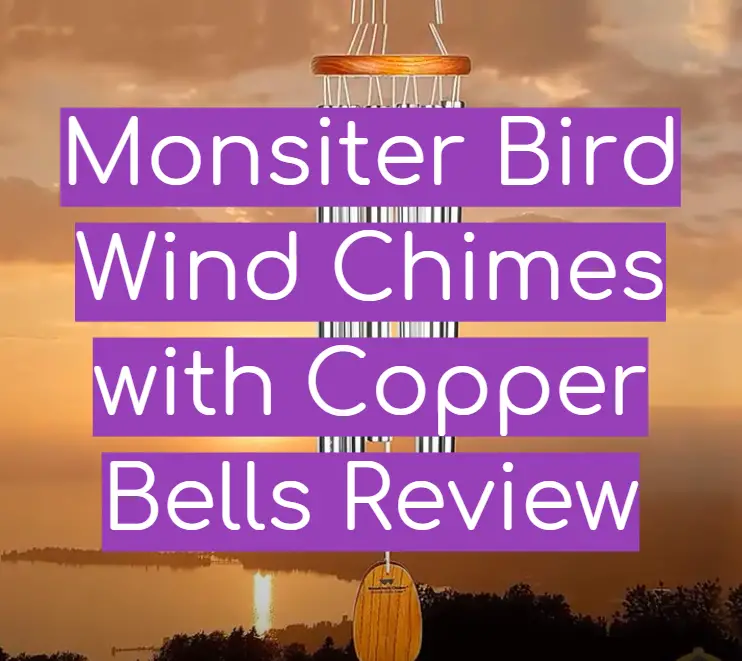
Leave a Reply